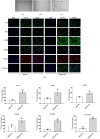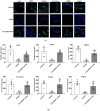Differentiation of cultured hair follicle neural crest stem cells into functional melanocytes
- PMID: 39170163
- PMCID: PMC11336637
- DOI: 10.1016/j.heliyon.2024.e35295
Differentiation of cultured hair follicle neural crest stem cells into functional melanocytes
Abstract
Many autologous melanocytes are required for surgical treatment of depigmentation diseases such as vitiligo. However, primary cultured melanocytes have a limited number of in vitro passages. The production of functional epidermal melanocytes from stem cells provides an unprecedented source of cell therapy for vitiligo. This study explores the clinical application of melanocytes induced by hair follicle neural crest stem cells (HFNCSCs). This study established an in vitro differentiation model of HFNCSCs into melanocytes. Results demonstrate that most differentiated melanocytes expressed the proteins C-KIT, MITF, S-100B, TYRP1, TYRP2, and tyrosinase. The HFNCSC-derived melanocytes were successfully transplanted onto the dorsal skin of mice and survived in the local tissues, expressing marker protein of melanocytes. In conclusion, HFNCSCs in mice can be induced to differentiate into melanocytes under specific conditions. These induced melanocytes exhibit the potential to facilitate repigmentation in the lesion areas of vitiligo-affected mice, suggesting a promising avenue for therapeutic intervention.
Keywords: Differentiation; Hair follicle neural crest stem cells (HFNCSCs); Melanocyte; Transplantation; Vitiligo.
© 2024 Published by Elsevier Ltd.
Conflict of interest statement
The authors declare no competing interests.
Figures





Similar articles
-
BMP4-Induced Differentiation of Human Hair Follicle Neural Crest Stem Cells into Precursor Melanocytes from Hair Follicle Bulge.Ann Dermatol. 2020 Oct;32(5):409-416. doi: 10.5021/ad.2020.32.5.409. Epub 2020 Sep 29. Ann Dermatol. 2020. PMID: 33911776 Free PMC article.
-
The effects of NB-UVB on the hair follicle-derived neural crest stem cells differentiating into melanocyte lineage in vitro.J Dermatol Sci. 2012 Apr;66(1):20-8. doi: 10.1016/j.jdermsci.2012.01.012. Epub 2012 Feb 16. J Dermatol Sci. 2012. PMID: 22391242
-
Experimental study and clinical observations of autologous hair follicle cell transplants to treat stable vitiligo.Indian J Dermatol Venereol Leprol. 2020 Mar-Apr;86(2):124-133. doi: 10.4103/ijdvl.IJDVL_261_18. Indian J Dermatol Venereol Leprol. 2020. PMID: 31397397
-
Repigmentation through Melanocyte Regeneration in Vitiligo.Dermatol Clin. 2017 Apr;35(2):205-218. doi: 10.1016/j.det.2016.11.015. Dermatol Clin. 2017. PMID: 28317529 Review.
-
Mechanisms of repigmentation induced by photobiomodulation therapy in vitiligo.Exp Dermatol. 2019 Feb;28 Suppl 1:10-14. doi: 10.1111/exd.13823. Exp Dermatol. 2019. PMID: 30698884 Review.
References
-
- Alkhateeb A., et al. Epidemiology of vitiligo and associated autoimmune diseases in caucasian probands and their families. Pigm. Cell Res. 2010;16(3):208–214. - PubMed
-
- Van Geel N., et al. Surgical techniques for vitiligo: a review. Dermatology. 2001;202(2):162–166. - PubMed
-
- Olsson M.J., Juhlin L. Long-term follow-up of leucoderma patients treated with transplants of autologous cultured melanocytes, ultrathin epidermal sheets and basal cell layer suspension. Br. J. Dermatol. 2002;147(5):893–904. - PubMed
-
- Van Geel N., et al. Modified technique of autologous noncultured epidermal cell transplantation for repigmenting vitiligo: a pilot study. Dermatol. Surg. 2001;27(10):873–876. - PubMed
LinkOut - more resources
Full Text Sources
Miscellaneous

